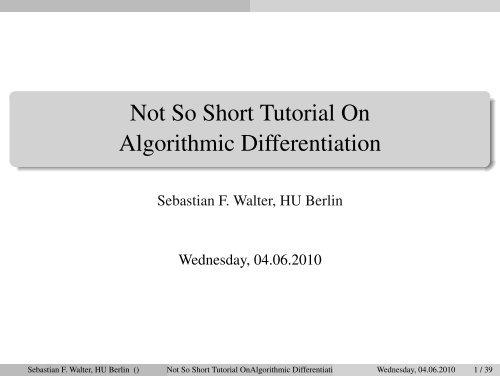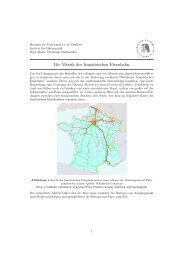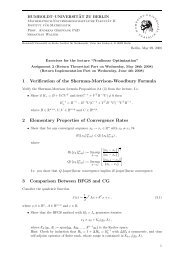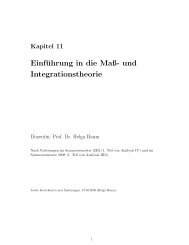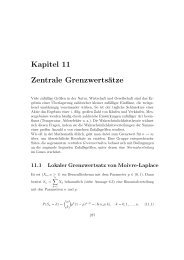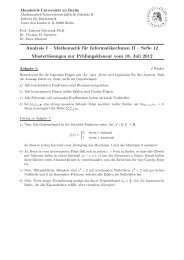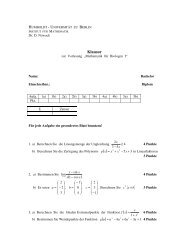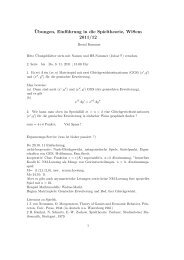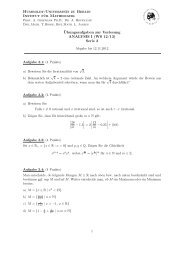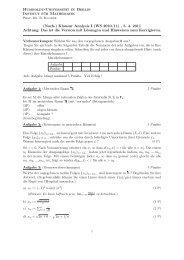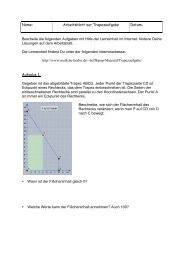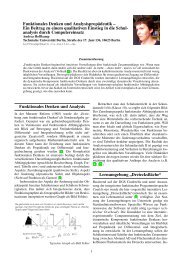AD Tutorial at the TU Berlin
AD Tutorial at the TU Berlin
AD Tutorial at the TU Berlin
You also want an ePaper? Increase the reach of your titles
YUMPU automatically turns print PDFs into web optimized ePapers that Google loves.
Not So Short <strong>Tutorial</strong> On<br />
Algorithmic Differenti<strong>at</strong>ion<br />
Sebastian F. Walter, HU <strong>Berlin</strong><br />
Wednesday, 04.06.2010<br />
Sebastian F. Walter, HU <strong>Berlin</strong> () Not So Short <strong>Tutorial</strong> OnAlgorithmic Differenti<strong>at</strong>ion Wednesday, 04.06.2010 1 / 39
Wh<strong>at</strong> is Algorithmic Differenti<strong>at</strong>ion?<br />
Name confusion: Algorithmic Differenti<strong>at</strong>ion aka Autom<strong>at</strong>ic<br />
Differenti<strong>at</strong>ion aka Comput<strong>at</strong>ional Differenti<strong>at</strong>ion aka <strong>AD</strong><br />
Considered one of <strong>the</strong> most important algorithmic techniques invented in<br />
<strong>the</strong> 20’th century 1<br />
Has distinct advantages over Finite Differences (FD) and Symbolic<br />
Differenti<strong>at</strong>ion (SD): more efficient and numerically stable and<br />
rel<strong>at</strong>ively easy to use.<br />
Can also be done by hand instead of symbolic differenti<strong>at</strong>ion (examples<br />
follow).<br />
1 Nick Trefe<strong>the</strong>n, http://www.comlab.ox.ac.uk/nick.trefe<strong>the</strong>n/inventorstalk.pdf<br />
Sebastian F. Walter, HU <strong>Berlin</strong> () Not So Short <strong>Tutorial</strong> OnAlgorithmic Differenti<strong>at</strong>ion Wednesday, 04.06.2010 2 / 39
Comput<strong>at</strong>ional Model<br />
computer programs are a sequence of elementary functions<br />
φ l ∈ {+, −, ∗, /, sin, exp, . . . }<br />
Example: Evalu<strong>at</strong>e Function f (3, 7):<br />
f : R 2 → R<br />
x ↦→ y = f (x) = sin(x 1 + cos(x 2 )x 1 )<br />
Comput<strong>at</strong>ional Trace:<br />
independent v −1 = x 1 = 3<br />
independent v 0 = x 2 = 7<br />
v 1 = φ 1 (v 0 ) = cos(v 0 )<br />
v 2 = φ 2 (v 1 , v −1 ) = v 1 v −1<br />
v 3 = φ 3 (v −1 , v 2 ) = v −1 + v 2<br />
v 4 = φ 4 (v 3 ) = sin(v 3 )<br />
dependent y = v 4<br />
Sebastian F. Walter, HU <strong>Berlin</strong> () Not So Short <strong>Tutorial</strong> OnAlgorithmic Differenti<strong>at</strong>ion Wednesday, 04.06.2010 3 / 39
Code Tracing with PY<strong>AD</strong>OLC<br />
import numpy ; from numpy import s i n , cos ; import a d o l c<br />
def f ( x ) :<br />
return s i n ( x [ 0 ] + cos ( x [ 1 ] ) ∗ x [ 0 ] )<br />
a d o l c . t r a c e o n ( 1 )<br />
x = a d o l c . a d o u b l e ( [ 3 , 7 ] ) ; a d o l c . i n d e p e n d e n t ( x )<br />
y = f ( x )<br />
a d o l c . d e p e n d e n t ( y ) ; a d o l c . t r a c e o f f ( )<br />
a d o l c . t a p e t o l a t e x ( 1 , [ 3 , 7 ] , [ 0 . ] )<br />
code op loc loc loc loc double double value value val<br />
33 start of tape<br />
39 take stock op 2 0 3.000000e + 00 n<br />
1 assign ind 0 3.000000e + 00<br />
1 assign ind 1 7.000000e + 00<br />
20 cos op 1 3 2 7.000000e + 00 6.569866e −<br />
15 mult a a 2 0 3 7.539023e − 01 3.000000e +<br />
11 plus a a 0 3 4 3.000000e + 00 2.261707e +<br />
21 sin op 4 6 5 5.261707e + 00 5.221055e −<br />
2 assign dep 5<br />
0 de<strong>at</strong>h not 0 6 −8.528809e −<br />
32 end of tape<br />
All <strong>AD</strong> tools (implicitly) work on <strong>the</strong> comput<strong>at</strong>ional trace.<br />
Sebastian F. Walter, HU <strong>Berlin</strong> () Not So Short <strong>Tutorial</strong> OnAlgorithmic Differenti<strong>at</strong>ion Wednesday, 04.06.2010 4 / 39
PART I:<br />
The Forward Mode of <strong>AD</strong>: Taylor Polynomial Arithmetic<br />
Sebastian F. Walter, HU <strong>Berlin</strong> () Not So Short <strong>Tutorial</strong> OnAlgorithmic Differenti<strong>at</strong>ion Wednesday, 04.06.2010 5 / 39
Algorithmic Differenti<strong>at</strong>ion ↔ Taylor Polynomial Arithmetic<br />
Basic Observ<strong>at</strong>ion: Let f : R N → R, <strong>the</strong>n<br />
d<br />
dt f (x + e nt)<br />
∣ = (∇ x f (x)) T · e n = ∂f ,<br />
t=0<br />
∂x n<br />
where e n is <strong>the</strong> n’th cartesian basis vector.<br />
complete gradient can be obtained by taking e 1 , e 2 , . . . , e N<br />
for not<strong>at</strong>ional brevity: introduction of <strong>the</strong> seed m<strong>at</strong>rix<br />
(∇ x f (x)) T · S = d dt f (x + St) ∣<br />
∣∣∣t=0<br />
e.g. S =<br />
( 1<br />
1)<br />
S ∈ R N×P doesn’t have to be square and not necessarily be <strong>the</strong> identity<br />
m<strong>at</strong>rix<br />
“using” a seed m<strong>at</strong>rix also leads comput<strong>at</strong>ionally more efficient<br />
algorithms (vectorized <strong>AD</strong>, e.g. adolc.hov forward)<br />
Sebastian F. Walter, HU <strong>Berlin</strong> () Not So Short <strong>Tutorial</strong> OnAlgorithmic Differenti<strong>at</strong>ion Wednesday, 04.06.2010 6 / 39
Univari<strong>at</strong>e Taylor Polynomial Arithmetic (UTP)<br />
Not<strong>at</strong>ion for UTPs:<br />
D−1<br />
∑<br />
[x] D := [x 0 , x 1 , . . . , x D−1 ] = x d T d ∈ R[T]/(T D ) ,<br />
d=0<br />
T is an indetermin<strong>at</strong>e, i.e. a formal parameter<br />
x d ∈ R is called Taylor coefficient<br />
a UTP is defined by <strong>the</strong> D coefficients x 0 , . . . , x D−1<br />
Definition of Functions on UTPs:<br />
E D (f ) : R[T]/(T D ) → R[T]/(T D )<br />
[x] D ↦→ [y] D := ∑ 1 d d D−1<br />
d! dt d f ( ∑<br />
x d t d )<br />
T d ,<br />
∣<br />
d=0<br />
k=0<br />
} {{ t=0<br />
}<br />
≡y d<br />
where f : R → R, y = f (x)<br />
Required: algorithms to compute y d for <strong>the</strong> elem. funcs. +, −, ∗, /, . . .<br />
Sebastian F. Walter, HU <strong>Berlin</strong> () Not So Short <strong>Tutorial</strong> OnAlgorithmic Differenti<strong>at</strong>ion Wednesday, 04.06.2010 7 / 39
UTP of <strong>the</strong> Multiplic<strong>at</strong>ion and Interpret<strong>at</strong>ion of UTP<br />
goal: compute [z] D = [x] D [y] D<br />
D−1<br />
∑<br />
z d T d =<br />
d=0<br />
=<br />
D−1<br />
∑<br />
D−1<br />
∑<br />
x d T d y d T d<br />
d=0<br />
d=0<br />
D−1<br />
∑ d∑<br />
( x d−k y k ) T d + O(T D )<br />
d=0 k=0<br />
} {{ }<br />
=z d<br />
Interpret<strong>at</strong>ion: The coefficients y d of [y] D = E D (f )([x] D ) s<strong>at</strong>isfy<br />
y d = dd f<br />
d d t (x 0 + 1t) ∣<br />
∣<br />
t=0<br />
= dd f<br />
d d x (x 0)<br />
if [x] D = [x 0 , 1, 0, . . . , 0]<br />
i.e. one gets higher-order deriv<strong>at</strong>ives by UTP arithmetic.<br />
Sebastian F. Walter, HU <strong>Berlin</strong> () Not So Short <strong>Tutorial</strong> OnAlgorithmic Differenti<strong>at</strong>ion Wednesday, 04.06.2010 8 / 39
Algorithms for Univari<strong>at</strong>e Taylor Polynomials over Scalars (UTPS)<br />
binary oper<strong>at</strong>ions<br />
unary oper<strong>at</strong>ions<br />
z = φ(x, y) d = 0, . . . , D OPS MOVES<br />
x + cy z d = x d + cy d 2D 3D<br />
x × y z d = P d<br />
k=0 h<br />
x ky d−k D 2 3D<br />
x/y z d = 1 x y d − P i<br />
d−1<br />
0 k=0 z ky d−k D 2 3D<br />
y = φ(x) d = 0, . . . , D OPS MOVES<br />
h<br />
ln(x) ỹ d = 1 ˜x x d − P i<br />
d−1<br />
0 k=1 x d−kỹ k D 2 2D<br />
exp(x) ỹ d = P d<br />
k=1 y d−k˜x k D 2 2D<br />
√ h<br />
x yd = 1 x 2y d − P i<br />
d−1<br />
0 k=1 y 1<br />
ky d−k 2 D2 3D<br />
h<br />
x r ỹ d = 1 r P d<br />
x 0 k=1 y d−k˜x k − P i<br />
d−1<br />
k=1 x d−kỹ k 2D 2 2D<br />
sin(v) ˜s d = P d<br />
j=1 ṽjc d−j 2D 2 3D<br />
cos(v) ˜c d = P d<br />
j=1 −ṽ js d−j<br />
tan(v) ˜φd = P d<br />
j=1 w d−jṽ j<br />
˜w d = 2 P d<br />
j=1 φ d−j “<br />
˜φ j<br />
arcsin(v) ˜φd = w −1<br />
0 ṽ d − P d−1<br />
j=1 w d−j ˜φ<br />
”<br />
j<br />
˜w d = − P d<br />
j=1 v d−j “<br />
˜φ j<br />
arctan(v) ˜φd = w −1<br />
0 ṽ d − P d−1<br />
j=1 w d−j ˜φ<br />
”<br />
j<br />
˜w d = 2 P d<br />
j=1 v d−jṽ j<br />
Sebastian F. Walter, HU <strong>Berlin</strong> () Not So Short <strong>Tutorial</strong> OnAlgorithmic Differenti<strong>at</strong>ion Wednesday, 04.06.2010 9 / 39
Live Example: Gradient Evalu<strong>at</strong>ion using TAYLORPOLY<br />
Function:<br />
f : R 2 → R<br />
Compute Gradient∇ x f (3, 7)<br />
( ) 1 0<br />
seed m<strong>at</strong>rix S =<br />
0 1<br />
x ↦→ y = f (x) = sin(x 1 + cos(x 2 )x 1 )<br />
import numpy ; from numpy import s i n , cos ; from t a y l o r p o l y import UTPS<br />
def f ( x ) :<br />
return s i n ( x [ 0 ] + cos ( x [ 1 ] ) ∗ x [ 0 ] ) + x [ 1 ] ∗ x [ 0 ]<br />
x = [ UTPS ( [ 3 , 1 , 0 ] , P = 2 ) , UTPS ( [ 7 , 0 , 1 ] , P = 2 ) ]<br />
y = f ( x )<br />
p r i n t ’ normal f u n c t i o n e v a l u a t i o n y 0 = f ( x 0 ) = ’ , y . d a t a [ 0 ]<br />
p r i n t ’ g r a d i e n t e v a l u a t i o n g ( x 0 ) = ’ , y . d a t a [ 1 : ]<br />
Sebastian F. Walter, HU <strong>Berlin</strong> () Not So Short <strong>Tutorial</strong> OnAlgorithmic Differenti<strong>at</strong>ion Wednesday, 04.06.2010 10 / 39
Higher-Order Mixed Partial Deriv<strong>at</strong>ives by UTP Arithmetic<br />
Always possible to compute higher-order mixed partial deriv<strong>at</strong>ives by<br />
evalu<strong>at</strong>ion/interpol<strong>at</strong>ion 2<br />
Example: Hessian H = [[f xx , f xy ], [f yx , f yy ]]<br />
〈s 1 |H|s 2 〉 = 1 2 [〈s 1|H|s 2 〉 + 〈s 2 |H|s 1 〉]<br />
= 1 2 [〈s 1 + s 2 − s 2 |H|s 2 〉 + 〈s 2 + s 1 − s 1 |H|s 1 〉]<br />
= 1 2 [〈s 1 + s 2 |H|s 1 + s 2 〉 − 〈s 1 |H|s 1 〉 − 〈s 2 |H|s 2 〉] .<br />
s T 1 ∇2 f (x)s 2 = ∂2 f (x + t 1 s 1 + t 2 s 2 )<br />
∂t 1 ∂t 2<br />
˛˛˛˛t1 =t 2 =0<br />
= 1 » ∂ 2 –<br />
f (x + t(s 1 + s 2 ))<br />
2 ∂t<br />
˛˛˛˛t=0 2 − ∂2 f (x + s 1 t)<br />
∂t 2 − ∂2 f (x + s 2 t)<br />
∂t 2 .<br />
to get H ij use s 1 = e i and s 2 = e j cartesian basis vectors<br />
2 Griewank et al., Evalu<strong>at</strong>ing Higher Deriv<strong>at</strong>ive Tensors by Forward Propag<strong>at</strong>ion of<br />
Univari<strong>at</strong>e Taylor Series,M<strong>at</strong>hem<strong>at</strong>ics of Comput<strong>at</strong>ion, 2000<br />
Sebastian F. Walter, HU <strong>Berlin</strong> () Not So Short <strong>Tutorial</strong> OnAlgorithmic Differenti<strong>at</strong>ion Wednesday, 04.06.2010 11 / 39
Live Example: Hessian Evalu<strong>at</strong>ion using TAYLORPOLY<br />
( ) 1 0 1<br />
f : R 2 → R, use seed m<strong>at</strong>rix S =<br />
and propag<strong>at</strong>e<br />
0 1 1<br />
( ( )<br />
3 1 0 1<br />
[x] 3 = +<br />
T<br />
7)<br />
0 1 1<br />
from t a y l o r p o l y import UTPS<br />
def f f c n ( x ) :<br />
return s i n ( x [ 0 ] + cos ( x [ 1 ] ) ∗ x [ 0 ] )<br />
S = a r r a y ( [ [ 1 , 0 , 1 ] , [ 0 , 1 , 1 ] ] , d t y p e = f l o a t )<br />
P = S . shape [ 1 ]<br />
p r i n t ’ seed m a t r i x w ith P = %d d i r e c t i o n s S = \n ’%P , S<br />
x1 = UTPS ( z e r o s (1+2∗P ) , P = P )<br />
x2 = UTPS ( z e r o s (1+2∗P ) , P = P )<br />
x1 . d a t a [ 0 ] = 3 ; x1 . d a t a [ 1 : : 2 ] = S [ 0 , : ]<br />
x2 . d a t a [ 0 ] = 7 ; x2 . d a t a [ 1 : : 2 ] = S [ 1 , : ]<br />
y = f f c n ( [ x1 , x2 ] )<br />
p r i n t ’ x1= ’ , x1 ; p r i n t ’ x2= ’ , x2 ; p r i n t ’ y= ’ , y<br />
H = z e r o s ( ( 2 , 2 ) , d t y p e = f l o a t )<br />
H[ 0 , 0 ] = 2∗y . c o e f f [ 0 , 2 ]<br />
H[ 1 , 0 ] = H[ 0 , 1 ] = ( y . c o e f f [ 2 , 2 ] − y . c o e f f [ 0 , 2 ] − y . c o e f f [ 1 , 2 ] )<br />
H[ 1 , 1 ] = 2∗y . c o e f f [ 1 , 2 ]<br />
Sebastian F. Walter, HU <strong>Berlin</strong> () Not So Short <strong>Tutorial</strong> OnAlgorithmic Differenti<strong>at</strong>ion Wednesday, 04.06.2010 12 / 39
PART II:<br />
The Reverse Mode of <strong>AD</strong><br />
Sebastian F. Walter, HU <strong>Berlin</strong> () Not So Short <strong>Tutorial</strong> OnAlgorithmic Differenti<strong>at</strong>ion Wednesday, 04.06.2010 13 / 39
The Reverse Mode by Hand:<br />
Recall: y = f (x) = sin(x 1 + cos(x 2 )x 1 )<br />
independent v −1 = x 1 = 3<br />
independent v 0 = x 2 = 7<br />
v 1 = φ 1 (v 0 ) = cos(v 0 )<br />
v 2 = φ 2 (v 1 , v −1 ) = v 1 v −1<br />
v 3 = φ 3 (v −1 , v 2 ) = v −1 + v 2<br />
v 4 = φ 4 (v 3 ) = sin(v 3 )<br />
dependent y = v 4<br />
Reverse Mode by Hand: Successive Pullbacks<br />
dy = dφ 4 (v 3 ) = ∂φ 4(z)<br />
∂z<br />
˛ dv 3 = cos(v 3 )<br />
˛z=v3<br />
= ¯v 3 dφ 3 (v −1 , v 2 ) = ¯v 3 dv −1 + ¯v 3<br />
|{z} |{z}<br />
=¯v −1<br />
= (¯v −1 + ¯v 2 v 1 ) dv −1 + ¯v 2 v −1 dv 1<br />
| {z } | {z }<br />
=¯v −1<br />
=¯v 1<br />
= ¯v −1 dv −1 + (−¯v 1 sin(v 0 )) dv 0<br />
| {z }<br />
=¯v 0<br />
Interpret<strong>at</strong>ion: ¯v −1 ≡ df and ¯v dx 0 ≡ df<br />
1 dx 2<br />
Need to store v 0 , v 1 , v 3 , v 4 for <strong>the</strong> reverse mode!<br />
dv 3<br />
| {z }<br />
=¯v 3<br />
=¯v 2<br />
dv 2<br />
Sebastian F. Walter, HU <strong>Berlin</strong> () Not So Short <strong>Tutorial</strong> OnAlgorithmic Differenti<strong>at</strong>ion Wednesday, 04.06.2010 14 / 39
Live Example: Semi-Autom<strong>at</strong>ic Reverse Mode<br />
import numpy ; from numpy import s i n , cos ; from t a y l o r p o l y import UTPS<br />
x1 = UTPS ( [ 3 , 1 , 0 ] , P = 2 ) ; x2 = UTPS ( [ 7 , 0 , 1 ] , P=2)<br />
# forward mode<br />
vm1 = x1<br />
v0 = x2<br />
v1 = cos ( v0 )<br />
v2 = v1 ∗ vm1<br />
v3 = vm1 + v2<br />
v4 = s i n ( v3 )<br />
y = v4<br />
# r e v e r s e mode<br />
v4bar = UTPS ( [ 0 , 0 , 0 ] , P = 2 ) ; v3bar = UTPS ( [ 0 , 0 , 0 ] , P=2)<br />
v2bar = UTPS ( [ 0 , 0 , 0 ] , P = 2 ) ; v1bar = UTPS ( [ 0 , 0 , 0 ] , P=2)<br />
v0bar = UTPS ( [ 0 , 0 , 0 ] , P = 2 ) ; vm1bar = UTPS ( [ 0 , 0 , 0 ] , P=2)<br />
v4bar . d a t a [ 0 ] = 1 .<br />
v3bar += v4bar ∗ cos ( v3 )<br />
vm1bar += v3bar ; v2bar += v3bar<br />
v1bar += v2bar ∗ vm1 ; vm1bar += v2bar ∗ v1<br />
v0bar −= v1bar ∗ s i n ( v0 )<br />
g1 = y . d a t a [ 1 : ] ; g2 = numpy . a r r a y ( [ vm1bar . d a t a [ 0 ] , v0bar . d a t a [ 0 ] ] )<br />
p r i n t ’UTPS g r a d i e n t g ( x 0 )= ’ , g1<br />
p r i n t ’ r e v e r s e g r a d i e n t g ( x 0 )= ’ , g2<br />
p r i n t ’ H e s s i a n H( x 0 )=\ n ’ , numpy . v s t a c k ( [ vm1bar . d a t a [ 1 : ] , v0bar . d a t a [ 1 : ] ] )<br />
Sebastian F. Walter, HU <strong>Berlin</strong> () Not So Short <strong>Tutorial</strong> OnAlgorithmic Differenti<strong>at</strong>ion Wednesday, 04.06.2010 15 / 39
Summary: Forward Mode and Reverse Mode<br />
Goal: compute Jacobian J = dF<br />
dx of function F : RN → R M<br />
Forward Mode: J = dF<br />
dx · S, where S = I ∈ RN×N<br />
needs N OPS(F) and MEM(J) ≤ N MEM(F)<br />
Reverse Mode: J = ¯S T · dF<br />
dx<br />
, where S = I ∈ RM×M<br />
OPS(J) ≈ M OPS(F) but MEM(J) ∼ OPS(F)<br />
Rule of Thumb: if 5M < N <strong>the</strong>n reverse mode most likely more efficient,<br />
but only if and only if <strong>the</strong>re is enough RAM!<br />
Partial Solution: can use Checkpointing to obtain logarithmic growth in<br />
<strong>the</strong> memory.<br />
For M ≪ N reverse mode will be <strong>the</strong> method of choice.<br />
Sebastian F. Walter, HU <strong>Berlin</strong> () Not So Short <strong>Tutorial</strong> OnAlgorithmic Differenti<strong>at</strong>ion Wednesday, 04.06.2010 16 / 39
PART III:<br />
Advanced <strong>AD</strong> and Applic<strong>at</strong>ions<br />
Sebastian F. Walter, HU <strong>Berlin</strong> () Not So Short <strong>Tutorial</strong> OnAlgorithmic Differenti<strong>at</strong>ion Wednesday, 04.06.2010 17 / 39
Optimum Experimental Design in Chemical Engineering<br />
Tetramethyl<br />
Cyclohexadien<br />
+<br />
k2 + C<strong>at</strong><br />
Pi−Complex +<br />
C<strong>at</strong><br />
λ<br />
Maleinacid<br />
Anhydrid<br />
Maleinacid<br />
Anhydrid<br />
Deactiv. C<strong>at</strong><br />
k1<br />
k3<br />
Diels−Alder<br />
Product<br />
− C<strong>at</strong><br />
non-c<strong>at</strong>alyzed and c<strong>at</strong>alyzed reaction p<strong>at</strong>h<br />
deactiv<strong>at</strong>ion of <strong>the</strong> c<strong>at</strong>alyst<br />
b<strong>at</strong>ch process<br />
measurements: product mass concentr<strong>at</strong>ion<br />
control of educt molar numbers, c<strong>at</strong>alyst<br />
concentr<strong>at</strong>ion, temper<strong>at</strong>ure profile<br />
five unknown model parameters<br />
ṅ 1 = −k · n1 · n 2<br />
m tot<br />
, n 1 (0) = n a1<br />
ṅ 2 = −k · n1 · n 2<br />
m tot<br />
, n 2 (0) = n a2<br />
ṅ 3 = k · n1 · n 2<br />
m tot<br />
, n 3 (0) = 0<br />
k = k 1 · exp − E 1<br />
R ·<br />
1<br />
T − 1<br />
!!<br />
T ref<br />
+ k k<strong>at</strong> · c k<strong>at</strong> · exp (−λ · t) · exp − E k<strong>at</strong><br />
R ·<br />
n 4 = n a4 T = ϑ + 273<br />
m tot = n 1 · M 1 + n 2 · M 2 + n 3 · M 3 + n 4 · M 4<br />
1<br />
T − 1<br />
!!<br />
T ref<br />
Sebastian F. Walter, HU <strong>Berlin</strong> () Not So Short <strong>Tutorial</strong> OnAlgorithmic Differenti<strong>at</strong>ion Wednesday, 04.06.2010 18 / 39
Optimum Experimental Design in Chemical Engineering (Cont.)<br />
Dynamics: Defined by ODE<br />
Goal: Estim<strong>at</strong>e parameters p = (k 1 , k k<strong>at</strong> , E k<strong>at</strong> )<br />
Problem: Errors in <strong>the</strong> measurements η result in errors in parameters p.<br />
nonlinear regression with additive iid normal errors<br />
η m = h m(t m, x(t m), p, q) + ε m ,<br />
ε m ∼ N (0, σ 2 m )<br />
m = 1, . . . , N M<br />
η m are measurements, h measurement model function (connects model to <strong>the</strong> real world)<br />
Controls q = (n a1 , n a2 , n a4 , c k<strong>at</strong> , θ) influence <strong>the</strong> error propag<strong>at</strong>ion.<br />
Therefore: Find controls q such th<strong>at</strong> <strong>the</strong> “uncertainty” in p is as “small” as possible.<br />
η 2<br />
ˆη(q 1 )<br />
ˆη(q 2 )<br />
J † (q)<br />
p 2<br />
ˆp(q 1 )<br />
ˆp(q 2 )<br />
Sebastian F. Walter, HU <strong>Berlin</strong> () Not So Short <strong>Tutorial</strong> OnAlgorithmic Differenti<strong>at</strong>ion Wednesday, 04.06.2010 19 / 39<br />
η 1<br />
p 1
Overall Objective Function<br />
Part I: Comput<strong>at</strong>ion of J 1 and J 2<br />
J 1 [n mts, :] =<br />
√ wmts<br />
d<br />
σ nmts (x(t nmts ; s, u(t nmts ; q), q) d(p, s) (h(tnmts , x(t nmts ; s, u(t nmts ; q), p)))<br />
J 2 =<br />
d<br />
r(q, p, s)<br />
d(p, s)<br />
Part II: Numerical Linear Algebra<br />
„<br />
J T<br />
C(J 1 , J 2 ) = (I, 0) 1 J 1 J2<br />
T « −1 „ « I<br />
J 2 0 0<br />
”<br />
=<br />
“Q T 2 (Q 2J1 T J 1Q T 2 )−1 Q 2<br />
where J2 T = (QT 1 , QT 2 )(L, 0)T<br />
Comput<strong>at</strong>ional Graph<br />
[p]<br />
[h], [r] [J 1], [J 2] [C] [Φ]<br />
Φ = λ 1 (C) , max. eigenvalue<br />
[q]<br />
[s] [x 0] [x 1] [x 2] [x 3] [x 4] . . . [x Nmts−1] [xNmts ]<br />
st<strong>at</strong>ex(t) <strong>at</strong>measurementtimes (mts) independent/dependent variables<br />
N mts Number measurment times, σ std of a measurement, q controls, p n<strong>at</strong>ure given parameter, s<br />
pseudo-Parameter (e.g. initial values), u control functions<br />
Sebastian F. Walter, HU <strong>Berlin</strong> () Not So Short <strong>Tutorial</strong> OnAlgorithmic Differenti<strong>at</strong>ion Wednesday, 04.06.2010 20 / 39
Differenti<strong>at</strong>ion of ODE Solvers<br />
Explicit Euler:<br />
x k+1 = x k + h k f (t k , x k , p)<br />
want x(t) and dx<br />
dp (t) <strong>at</strong> t = [t 1, t 2 , . . . , t Nmts ]<br />
Idea: look <strong>at</strong> comput<strong>at</strong>ion trace of <strong>the</strong> x k<br />
Apply Standard <strong>AD</strong> techniques + some tricks<br />
Approach also works for implicit schemes as needed for DAEs<br />
(DAESOL-II)<br />
[p]<br />
[h], [r] [J 1 ], [J 2 ] [C] [Φ]<br />
[q]<br />
[s] [x 0 ] [x 1 ] [x 2 ] [x 3 ] [x 4 ] . . . [x N mts−1] [x N mts ]<br />
st<strong>at</strong>ex(t) <strong>at</strong>measurementtimes (mts)<br />
independent/dependent variables<br />
Sebastian F. Walter, HU <strong>Berlin</strong> () Not So Short <strong>Tutorial</strong> OnAlgorithmic Differenti<strong>at</strong>ion Wednesday, 04.06.2010 21 / 39
Live Example: UTPS of Explicit Euler<br />
import numpy ; from numpy import s i n , cos ; from t a y l o r p o l y import UTPS<br />
x = numpy . a r r a y ( [ UTPS ( [ 1 , 0 , 0 ] , P = 2 ) , UTPS ( [ 0 , 0 , 0 ] , P = 2 ) ] )<br />
p = UTPS ( [ 3 , 1 , 0 ] , P=2)<br />
def f ( x ) :<br />
return numpy . a r r a y ( [ x [1] , − p ∗ x [ 0 ] ] )<br />
t s = numpy . l i n s p a c e ( 0 , 2 ∗ numpy . pi , 1 0 0 )<br />
x l i s t = [ [ x i . d a t a . copy ( ) f o r x i in x ] ]<br />
f o r n t s in r a n g e ( t s . s i z e −1):<br />
h = t s [ n t s +1] − t s [ n t s ]<br />
x = x + h ∗ f ( x )<br />
x l i s t . append ( [ x i . d a t a . copy ( ) f o r x i in x ] )<br />
xs = numpy . a r r a y ( x l i s t )<br />
import m a t p l o t l i b . p y p l o t as p y p l o t<br />
p y p l o t . p l o t ( t s , xs [ : , 0 , 0 ] , ’ . k−’ , l a b e l = r ’ $x ( t ) $ ’ )<br />
p y p l o t . p l o t ( t s , xs [ : , 0 , 1 ] , ’ . r−’ , l a b e l = r ’ $x p ( t ) $ ’ )<br />
p y p l o t . x l a b e l ( ’ t ime $ t $ ’ )<br />
p y p l o t . l e g e n d ( l o c = ’ b e s t ’ )<br />
p y p l o t . g r i d ( )<br />
p y p l o t . show ( )<br />
Sebastian F. Walter, HU <strong>Berlin</strong> () Not So Short <strong>Tutorial</strong> OnAlgorithmic Differenti<strong>at</strong>ion Wednesday, 04.06.2010 22 / 39
Applic<strong>at</strong>ion Example: DAESOL-II for Least-Squares<br />
2<br />
1<br />
0<br />
x(t; p)<br />
−1<br />
−2<br />
x 1 (t; p = 1.0)<br />
x 2 (t; p = 1.0)<br />
dx 1/dp(t; p = 1.0)<br />
dx 2 /dp(t; p = 1.0)<br />
η 1<br />
−3<br />
−4<br />
0 1 2 3 4 5<br />
t<br />
DAESOL-II can already do forward/reverse UTP<br />
UTP in DAESOL-II is approaching m<strong>at</strong>urity now<br />
η 2<br />
x 1 (t; p = 1.6)<br />
x 2 (t; p = 1.6)<br />
Sebastian F. Walter, HU <strong>Berlin</strong> () Not So Short <strong>Tutorial</strong> OnAlgorithmic Differenti<strong>at</strong>ion Wednesday, 04.06.2010 23 / 39
Differenti<strong>at</strong>ing Implicitly Defined Function with Newton’s Method<br />
Many functions are implicitly defined by algebraic equ<strong>at</strong>ions:<br />
multiplic<strong>at</strong>ive inverse: y = x −1 by 0 = xy − 1<br />
in general for independent x and dependent y:<br />
0 = F(x, y)<br />
Newton’s Method 3 : Let F([x], [y] D ) D = 0 and F ′ ([x], [y] D ) mod t D<br />
invertible. Then<br />
0 D+E = F([x], [y] D+E )<br />
0 D+E = F([x], [y] D ) + F ′ ([x], [y] D )[∆y] E t D<br />
[∆y] E<br />
E = −<br />
(<br />
F ′ ([x], [y] E<br />
) −1 [∆F]E<br />
[X] D ≡ [X 0 , . . . , x D−1 ] ≡ ∑ D−1<br />
d=0 x dt d , [∆F] E t D D+E = F([x], [y] D )<br />
if E = D <strong>the</strong>n number of correct coefficients is doubled<br />
3 also called Newton-Hensel lifting or Hensel lifting<br />
Sebastian F. Walter, HU <strong>Berlin</strong> () Not So Short <strong>Tutorial</strong> OnAlgorithmic Differenti<strong>at</strong>ion Wednesday, 04.06.2010 24 / 39
Univari<strong>at</strong>e Taylor Propag<strong>at</strong>ion on M<strong>at</strong>rices (UTPM)<br />
Applic<strong>at</strong>ion of Newton’s Method to defining equ<strong>at</strong>ions<br />
Defining equ<strong>at</strong>ions of <strong>the</strong> QR decomposition:<br />
0<br />
0<br />
0<br />
D<br />
= [Q] D [R] D − [A] D<br />
D<br />
= [Q] T D [Q] D − I<br />
D<br />
= P L ◦ [R] D ,<br />
where (P L ) ij = δ i>j and element-wise multiplic<strong>at</strong>ion ◦.<br />
Defining equ<strong>at</strong>ions of <strong>the</strong> symmetric eigenvalue decomposition<br />
0<br />
0<br />
0<br />
D<br />
= [Q] T D [A] D[Q] D − [Λ] D<br />
D<br />
= [Q] T D [Q] D − I<br />
D<br />
= (P L + P R ) ◦ [Λ] D .<br />
Defining equ<strong>at</strong>ions of <strong>the</strong> Cholesky Decomposition<br />
etc...<br />
0<br />
0<br />
0<br />
D<br />
= [L] D [L] T D − [a] D<br />
D<br />
= P D ◦ [L] D − I<br />
D<br />
= P R ◦ [L] D .<br />
Sebastian F. Walter, HU <strong>Berlin</strong> () Not So Short <strong>Tutorial</strong> OnAlgorithmic Differenti<strong>at</strong>ion Wednesday, 04.06.2010 25 / 39
Algorithm: Forward UTPM of <strong>the</strong> Rectangular QR Decomposition<br />
input : [A] D = [A 0 , . . . , A D− 1], where A d ∈ R M×N , d = 0, . . . , D − 1, M ≥ N.<br />
output: [Q] D = [Q 0 , . . . , Q D− 1] m<strong>at</strong>rix with orthonormal column vectors, where Q d ∈ R M×N ,<br />
d = 0, . . . , D − 1<br />
output: [R] D = [R 0 , . . . , R D− 1] upper triangular, where R d ∈ R N×N , d = 0, . . . , D − 1<br />
Q 0 , R 0 = qr (A 0 )<br />
for d = 1 to D − 1 do<br />
∆F = A d − P d−1<br />
k=1 Q d−kR k<br />
S = − 1 P d−1<br />
2 k=1 QT d−k Q k<br />
P L ◦ X = P L ◦ (Q T 0 ∆FR−1 0 − S)<br />
X = P L ◦ X − (P L ◦ X) T<br />
R d = Q T 0 ∆F − (S + X)R 0<br />
Q d = (∆F − Q 0 R d )R −1<br />
0<br />
end<br />
Sebastian F. Walter, HU <strong>Berlin</strong> () Not So Short <strong>Tutorial</strong> OnAlgorithmic Differenti<strong>at</strong>ion Wednesday, 04.06.2010 26 / 39
Algorithm: Reverse UTPM of <strong>the</strong> Rectangular QR Decomposition<br />
input : [A] D = [A 0 , . . . , A D− 1], where A d ∈ R M×N , d = 0, . . . , D − 1, M ≥ N.<br />
output : [Q] D = [Q 0 , . . . , Q D− 1] m<strong>at</strong>rix with orthonormal column vectors, where Q d ∈ R M×N ,<br />
d = 0, . . . , D − 1<br />
output : [R] D = [R 0 , . . . , R D− 1] upper triangular, where R d ∈ R N×N , d = 0, . . . , D − 1<br />
input/output: [Ā] D = [Ā 0 , . . . , Ā D− 1], where Ā d ∈ R M×N , d = 0, . . . , D − 1, M ≥ N.<br />
input : [¯Q] D = [¯Q 0 , . . . , ¯Q D− 1], where ¯Q d ∈ R M×N , d = 0, . . . , D − 1<br />
input : [¯R] D = [¯R 0 , . . . , ¯R D− 1], where ¯R d ∈ R N×N , d = 0, . . . , D − 1<br />
[Ā] D = [Ā] D + ([¯Q] D − [Q] D [Q] T D [¯Q] D )[R] −T<br />
D )<br />
+[Q] D<br />
“[¯R] D + P L ◦ `[R] D [¯R] T D − [¯R] D [R] T D + [Q]T D [¯Q] D − [¯Q] T D [Q] ´ ”<br />
D [R]<br />
−T<br />
D<br />
Sebastian F. Walter, HU <strong>Berlin</strong> () Not So Short <strong>Tutorial</strong> OnAlgorithmic Differenti<strong>at</strong>ion Wednesday, 04.06.2010 27 / 39
ALGOPY Live Example: QR decomposition<br />
import numpy ; from a l g o p y import UTPM<br />
# QR decomposition , UTPM forward<br />
D, P ,M,N = 3 , 1 , 5 , 2<br />
A = UTPM( numpy . random . rand (D, P ,M,N) )<br />
Q, R = UTPM. qr (A)<br />
B = UTPM. d o t (Q, R)<br />
# check t h a t <strong>the</strong> r e s u l t s are c o r r e c t<br />
p r i n t ’Q. T Q − 1\n ’ ,UTPM. d o t (Q. T ,Q) − numpy . eye (N)<br />
p r i n t ’QR − A\n ’ ,B − A<br />
p r i n t ’ t r i u (R) − R\n ’ , UTPM. t r i u (R) − R<br />
# QR decomposition , UTPM r e v e r s e<br />
Bbar = UTPM( numpy . random . rand (D, P ,M,N) )<br />
Qbar , Rbar = UTPM. p b d o t ( Bbar , Q, R , B)<br />
Abar = UTPM. p b q r ( Qbar , Rbar , A, Q, R)<br />
p r i n t<br />
’ Abar − Bbar \n ’ , Abar − Bbar<br />
Sebastian F. Walter, HU <strong>Berlin</strong> () Not So Short <strong>Tutorial</strong> OnAlgorithmic Differenti<strong>at</strong>ion Wednesday, 04.06.2010 28 / 39
ALGOPY Live Example: Moore-Penrose Pseudo inverse<br />
import numpy ; from algopy import CGraph , F unction , UTPM, dot , qr , eigh , in<br />
D, P ,M,N = 2 , 1 , 5 , 2<br />
# g e n e r a t e badly c o n d i t i o n e d m<strong>at</strong>rix A<br />
A = UTPM( numpy . z e r o s ( ( D, P ,M,N ) ) )<br />
x = UTPM( numpy . z e r o s ( ( D, P ,M, 1 ) ) ) ; y = UTPM( numpy . z e r o s ( ( D, P ,M, 1 ) ) )<br />
x . d a t a [ 0 , 0 , : , 0 ] = [ 1 , 1 , 1 , 1 , 1 ] ; x . d a t a [ 1 , 0 , : , 0 ] = [ 1 , 1 , 1 , 1 , 1 ]<br />
y . d a t a [ 0 , 0 , : , 0 ] = [ 1 , 2 , 1 , 2 , 1 ] ; y . d a t a [ 1 , 0 , : , 0 ] = [ 1 , 2 , 1 , 2 , 1 ]<br />
a l p h a = 10∗∗−5; A = d o t ( x , x . T ) + a l p h a ∗ d o t ( y , y . T ) ; A = A [ : , : 2 ]<br />
# Method 1: Naive approach<br />
Apinv = d o t ( i n v ( d o t (A. T ,A) ) ,A. T )<br />
p r i n t ’ n a i v e a p p r o a c h : A Apinv A − A = 0 \n ’ , d o t ( d o t (A, Apinv ) ,A) − A<br />
p r i n t ’ n a i v e a p p r o a c h : Apinv A Apinv − Apinv = 0 \n ’ , d o t ( d o t ( Apinv , A) , Ap<br />
p r i n t ’ n a i v e a p p r o a c h : ( Apinv A) ˆ T − Apinv A = 0 \n ’ , d o t ( Apinv , A ) . T − d<br />
p r i n t ’ n a i v e a p p r o a c h : (A Apinv ) ˆ T − A Apinv = 0 \n ’ , d o t (A, Apinv ) . T − d<br />
# Method 2: Using <strong>the</strong> d i f f e r e n t i a t e d QR decomposition<br />
Q, R = qr (A)<br />
tmp1 = s o l v e (R . T , A. T )<br />
tmp2 = s o l v e (R , tmp1 )<br />
Apinv = tmp2<br />
p r i n t ’QR a p p r o a c h : A Apinv A − A = 0 \n ’ , d o t ( d o t (A, Apinv ) ,A) − A<br />
p r i n t ’QR a p p r o a c h : Apinv A Apinv − Apinv = 0 \n ’ , d o t ( d o t ( Apinv , A) , Apinv<br />
p r i n t ’QR a p p r o a c h : ( Apinv A) ˆ T − Apinv A = 0 \n ’ , d o t ( Apinv , A ) . T − d o t (<br />
p r i n t ’QR a p p r o a c h : (A Apinv ) ˆ T − A Apinv = 0 \n ’ , d o t (A, Apinv ) . T − d o t (<br />
Sebastian F. Walter, HU <strong>Berlin</strong> () Not So Short <strong>Tutorial</strong> OnAlgorithmic Differenti<strong>at</strong>ion Wednesday, 04.06.2010 29 / 39
Algorithm: Forward UTPM of Symmetric Eigenvalue Decomposition<br />
input : [A] D = [A 0 , . . . , A D− 1], where A d ∈ R N×N symmetric positive definite, d = 0, . . . , D − 1<br />
output: [˜Λ] D = [˜Λ 0 , . . . , ˜Λ D− 1], where Λ 0 ∈ R N×N diagonal and Λ d ∈ R N×N block diagonal<br />
d = 1, . . . , D − 1.<br />
output: b ∈ N N b+1 , array of integers defining <strong>the</strong> blocks. The integer N B is <strong>the</strong> number of blocks. Each<br />
block has <strong>the</strong> size of <strong>the</strong> multiplicity of an eigenvalue λ nb of Λ 0 s.t. for sl = b[n b ] : b[n b + 1] one<br />
has (Q 0 [:, sl ]) T A 0 Q 0 [:, sl ] = λ nb I.<br />
Λ 0 , Q 0 = eigh (A 0 )<br />
E ij = (Λ 0 ) jj − (Λ 0 ) ii<br />
H = P B ◦ (1/E)<br />
for d = 1 to D − 1 do<br />
S = − 1 2<br />
end<br />
P d−1<br />
k=1 QT d−k Q k<br />
K = ∆F + ˜Q T 0 A d ˜Q 0 + SΛ 0 + Λ 0 S<br />
˜Q d = Q 0 (S + H ◦ K)<br />
˜Λ d = ¯P B ◦ K<br />
for <strong>the</strong> special case of distinct eigenvalues, this algorithm suffices<br />
for repe<strong>at</strong>ed eigenvalues this algorithm is one step in a little more involved algorithm<br />
Sebastian F. Walter, HU <strong>Berlin</strong> () Not So Short <strong>Tutorial</strong> OnAlgorithmic Differenti<strong>at</strong>ion Wednesday, 04.06.2010 30 / 39
Test Example for <strong>the</strong> Symmetric Eigenvalue Decomposition 4<br />
Orthonormal M<strong>at</strong>rix:<br />
0<br />
1<br />
cos(x(t)) 1 sin(x(t)) −1<br />
1<br />
Q(t) = √ B− sin(x(t)) −1 cos(x(t)) −1<br />
C<br />
3<br />
@ 1 − sin(x(t)) 1 cos(x(t)) A<br />
−1 cos(x(t)) 1 sin(x(t))<br />
Λ(t) = diag(x 2 − x + 1 2 , 4x2 − 3x, δ(− 1 2 x3 + 2x 2 − 3 2 x + 1) + (x3 + x 2 − 1), 3x − 1) ,<br />
where x ≡ x(t) := 1 + t.<br />
constant δ = 0 means repe<strong>at</strong>ed eigenvalues, δ > 0 distinct but close<br />
In Taylor arithmetic one obtains<br />
Λ 0 = diag(1/2, 1, 1 + δ, 2)<br />
Λ 1 = diag(1, 5, 5 + δ, 3)<br />
Λ 2 = diag(2, 8, 8 + δ, 0)<br />
Λ 3 = diag(0, 0, 6 − 3δ, 0)<br />
Λ d = diag(0, 0, 0, 0), ∀d ≥ 4 .<br />
Define A(t) = Q(t)Λ(t)Q(t) and try to reconstruct Λ(t) and Q(t).<br />
4 Example adapted from Andrew and Tan, Comput<strong>at</strong>ion of Deriv<strong>at</strong>ives of Repe<strong>at</strong>ed<br />
Eigenvalues and <strong>the</strong> Corresponding Eigenvectors of Symmetric M<strong>at</strong>rix Pencils, SIAM Journal<br />
on M<strong>at</strong>rix Analysis and Applic<strong>at</strong>ions<br />
Sebastian F. Walter, HU <strong>Berlin</strong> () Not So Short <strong>Tutorial</strong> OnAlgorithmic Differenti<strong>at</strong>ion Wednesday, 04.06.2010 31 / 39
Test Example for <strong>the</strong> Symmetric Eigenvalue Decomposition (cont.)<br />
abs. error |λ 1 d − ˜λ 1 d |<br />
10 −14<br />
10 −15<br />
10 −16<br />
d = 0<br />
d = 1<br />
d = 2<br />
d = 3<br />
d = 4<br />
errors of λ 1<br />
10 −17<br />
10 −15 10 −14 10 −13 10 −12 10 −11 10 −10 10 −9 10 −8 10 −7 10 −6 10 −5 10 −4 10 −3 10 −2 10 −1 10 0<br />
δ<br />
Sebastian F. Walter, HU <strong>Berlin</strong> () Not So Short <strong>Tutorial</strong> OnAlgorithmic Differenti<strong>at</strong>ion Wednesday, 04.06.2010 32 / 39
Test Example for <strong>the</strong> Symmetric Eigenvalue Decomposition (cont.)<br />
abs. error |λ 2 d − ˜λ 2 d |<br />
10 −8<br />
10 −9<br />
10 −10<br />
10 −11<br />
10 −12<br />
10 −13<br />
10 −14<br />
10 −15<br />
errors of λ 2 d = 0<br />
d = 1<br />
d = 2<br />
d = 3<br />
d = 4<br />
10 −16<br />
10 −17<br />
10 −18<br />
10 −15 10 −14 10 −13 10 −12 10 −11 10 −10 10 −9 10 −8 10 −7 10 −6 10 −5 10 −4 10 −3 10 −2 10 −1 10 0<br />
δ<br />
Sebastian F. Walter, HU <strong>Berlin</strong> () Not So Short <strong>Tutorial</strong> OnAlgorithmic Differenti<strong>at</strong>ion Wednesday, 04.06.2010 33 / 39
Test Example for <strong>the</strong> Symmetric Eigenvalue Decomposition (cont.)<br />
abs. error |λ 3 d − ˜λ 3 d |<br />
10 −8<br />
10 −9<br />
10 −10<br />
10 −11<br />
10 −12<br />
10 −13<br />
errors of λ 3 d = 0<br />
d = 1<br />
d = 2<br />
d = 3<br />
d = 4<br />
10 −14<br />
10 −15<br />
10 −16<br />
10 −15 10 −14 10 −13 10 −12 10 −11 10 −10 10 −9 10 −8 10 −7 10 −6 10 −5 10 −4 10 −3 10 −2 10 −1 10 0<br />
δ<br />
Sebastian F. Walter, HU <strong>Berlin</strong> () Not So Short <strong>Tutorial</strong> OnAlgorithmic Differenti<strong>at</strong>ion Wednesday, 04.06.2010 34 / 39
Test Example for <strong>the</strong> Symmetric Eigenvalue Decomposition (cont.)<br />
abs. error |λ 4 d − ˜λ 4 d |<br />
10 −14<br />
10 −15<br />
10 −16<br />
errors of λ 4 d = 0<br />
d = 1<br />
d = 2<br />
d = 3<br />
d = 4<br />
10 −17<br />
10 −15 10 −14 10 −13 10 −12 10 −11 10 −10 10 −9 10 −8 10 −7 10 −6 10 −5 10 −4 10 −3 10 −2 10 −1 10 0<br />
δ<br />
Sebastian F. Walter, HU <strong>Berlin</strong> () Not So Short <strong>Tutorial</strong> OnAlgorithmic Differenti<strong>at</strong>ion Wednesday, 04.06.2010 35 / 39
The E-Criterion of <strong>the</strong> Opt. Exp. Design Problem<br />
Compute ∇ 2 qeigh(C(q)), where<br />
„<br />
J T<br />
C = (I, 0) 1 J 1 J2<br />
T « −1 „ « I<br />
.<br />
J 2 0 0<br />
import numpy<br />
from a l g o p y import CGraph , F unction , UTPM; from a l g o p y . g l o b a l f u n c s import<br />
def C( J1 , J2 ) :<br />
Np = J1 . shape [ 1 ] ; Nr = J2 . shape [ 0 ]<br />
tmp = z e r o s ( ( Np+Nr , Np+Nr ) , d t y p e =J1 )<br />
tmp [ : Np , : Np ] = d o t ( J1 . T , J1 )<br />
tmp [ Np : , : Np ] = J2<br />
tmp [ : Np , Np : ] = J2 . T<br />
return i n v ( tmp ) [ : Np , : Np ]<br />
D, P ,Nm, Np , Nr = 2 , 1 , 5 0 , 4 , 3<br />
cg = CGraph ( )<br />
J1 = F u n c t i o n (UTPM( numpy . random . r and (D, P ,Nm, Np ) ) )<br />
J2 = F u n c t i o n (UTPM( numpy . random . r and (D, P , Nr , Np ) ) )<br />
Phi = F u n c t i o n . e i g h (C( J1 , J2 ) ) [ 0 ] [ 0 ]<br />
cg . i n d e p e n d e n t F u n c t i o n L i s t = [ J1 , J2 ] ; cg . d e p e n d e n t F u n c t i o n L i s t = [ Phi ]<br />
cg . p l o t ( ’ p i c s / c g r a p h . svg ’ )<br />
Sebastian F. Walter, HU <strong>Berlin</strong> () Not So Short <strong>Tutorial</strong> OnAlgorithmic Differenti<strong>at</strong>ion Wednesday, 04.06.2010 36 / 39
Sebastian F. Walter, HU <strong>Berlin</strong> () Not So Short <strong>Tutorial</strong> OnAlgorithmic Differenti<strong>at</strong>ion Wednesday, 04.06.2010 37 / 39
Some Software for Forward/Reverse UTP<br />
Name Description St<strong>at</strong>us LOC<br />
algopy forward/reverse UTPM in Python alpha 10388<br />
www.github.com/b45ch1/algopy<br />
pysolvind Python Bindings to SolvIND/DAESOL-II alpha 9743<br />
pyadolc Python Bindings to <strong>AD</strong>OL-C (C++) stable 6895<br />
www.github.com/b45ch1/pyadolc<br />
pycppad Python Bindings to Cpp<strong>AD</strong> (C++ ) stable 1334<br />
www.github.com/b45ch1/pycppad<br />
taylorpoly ANSI-C with Python bindings alpha 9276<br />
www.github.com/b45ch1/taylorpoly<br />
Sebastian F. Walter, HU <strong>Berlin</strong> () Not So Short <strong>Tutorial</strong> OnAlgorithmic Differenti<strong>at</strong>ion Wednesday, 04.06.2010 38 / 39
Summary:<br />
Have shown many aspects of <strong>AD</strong>, in particular Univari<strong>at</strong>e Taylor<br />
Polynomial arithmetic and <strong>the</strong> Reverse Mode<br />
There are many useful tools in Python th<strong>at</strong> ease prototyping<br />
TAYLORPOLY hosts ANSI-C algorithms th<strong>at</strong> can be used from basically<br />
all programming languages<br />
Outlook:<br />
Reverse mode of QR decomposition of quadr<strong>at</strong>ic by singular m<strong>at</strong>rices<br />
Reverse mode of <strong>the</strong> symmetric eigenvalue decomposition for <strong>the</strong> case of<br />
repe<strong>at</strong>ed eigenvalues<br />
derive UTPM algorithm for <strong>the</strong> Singular Value Decomposition and<br />
generalized eigenvalue decomposition<br />
port all existing algorithms from ALGOPY to TAYLORPOLY<br />
Sebastian F. Walter, HU <strong>Berlin</strong> () Not So Short <strong>Tutorial</strong> OnAlgorithmic Differenti<strong>at</strong>ion Wednesday, 04.06.2010 39 / 39


